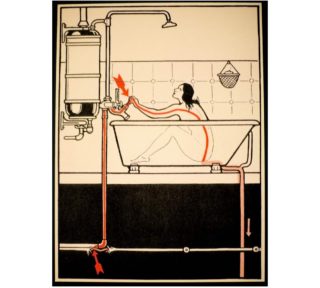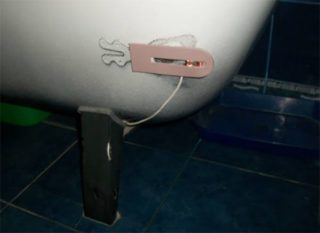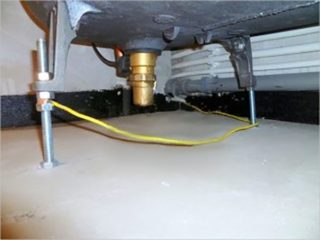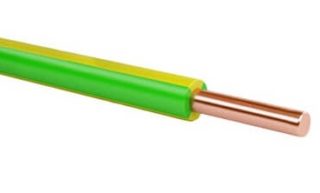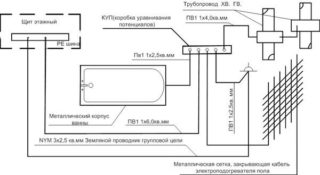The bathroom is a potentially dangerous place. High humidity and electrical appliances can cause serious harm to humans. A washing machine, a heated bathtub, a water heater, and even a hairdryer are high voltage sources. That is why it is important to think about how to ground in the bathroom.
Why ground
Before deciding on a job, you need to study the theory. It is important to understand how the grounding conductor works, why it is needed and how to make the connection correctly.
Grounding is an additional protection for electric leakage. The conductor consists of a cable with copper conductors. One contact is connected to the housing, the other goes to the ground. In case of contact with phase and zero, the wire will pick up the current and redirect it to the ground. Such a connection scheme can protect against electric shock.
The bathroom is a source of high humidity, which means that any electrical appliance and an unprotected outlet can be dangerous. Over time, household appliances can fail. A common breakdown - the phase breaks through to the body. During contact between the conductive housing and the non-grounded surface, a person passes electricity through himself. A cast-iron or metal bath in this case serves as a conductor. To avoid injuries, it is enough to start current along the path of least resistance.
In a Soviet-style apartment building, there is no grounding. It was considered sufficient to connect the tub and piping to a common riser. This scheme will be working if the entire riser consists of elements conducting current. But in modern everyday life they use plastic sewers, which means this type of grounding will not work.
Connection of different types of bathtubs
Different bath materials require an individual approach. In everyday life there are several basic types of structures:
- cast iron;
- steel;
- acrylic;
- old style;
- jacuzzi.
The standard grounding of a cast-iron bathtub occurs by connecting conductive elements to grounded pipes. If we talk about modern products, then they already have a petal for convenient cable installation. All you need to do is connect the stranded conductor to the device using the bolt nut and washer.
Steel baths can be secured in several ways. If metal legs are welded to the body, fastening is carried out using a bolt and nut. You can also weld the wire directly to the wall. The main condition for good current transfer is the absence of paint, varnish or primer.
Acrylic is a dielectric, which means it is not able to pass current through itself. However, the acrylic construction must be grounded. There are two reasons requiring a set of work. The first - extruded bathtubs are equipped with a metal body. The second reason is that acrylic is able to accumulate static electricity, especially when collecting water.
In the bathtubs of the old model, contact pads for the ground wire are not provided. To make a connection, you need to drill a hole in the leg. Then the conductor should be bolted.
The principle of operation of the jacuzzi is based on the use of electric current. Therefore, connecting a hot tub to the ground is the first thing to do before use. To secure use, it is enough to install an outlet with grounding. It is important that it is protected against moisture.
Progress
Grounding a stationary bath in a house or apartment is not an easy task, requiring a minimum set of knowledge in electrics. Before starting work, it is necessary to familiarize yourself with the main points of the PUE (electrical installation rules).
When connecting by yourself, it is important to follow the step by step instructions. This reduces the chance of making a mistake. Grounding conductor installation can be completed in four steps:
- selection of materials before starting work;
- preparation of tools for electrical work;
- ground bus laying;
- grounding of electrical appliances.
According to the rules of electrical work, the ground conductor in a residential building must have a cross section of at least 6 mm2. The cable sheath is made of PVC and has a standard yellow and green color. If a bolted connection is used, it is important to choose stainless elements.
During work, a drill with a 6 mm diameter drill may be required. PH screwdriver, adjustable wrench and stripping tool. If there are no special pliers for braiding, you can use a knife. In some cases, a welding machine may be needed (for grounding the bathtub with a metal base).
The first step is to fix the bare wire on a special platform in the bathroom. When stripping insulation, the core must not be damaged. For an acceptable aesthetic appearance, the tire is put into the box, held under the bathtub or covered with plaster. After laying, the wire is connected to the grounding jumper.
Grounding also requires electrical appliances. Household appliances already have a third contact. For a correct connection, it is enough to purchase a special outlet and bring the wire to a common jumper.
Current protection device
In apartment buildings, grounding is rare. Basically, the electrical network is limited to two conductors - phase and zero. In the rare case, you can meet two power cables 220V. For such cases, there is a connection diagram through a neutral wire.
It is strictly forbidden to directly connect the ground wire to zero. Installation is only allowed with an electric shock protection device. Before starting work, you should make sure that the rules of SNIP and PUE are observed.
RCD is an automatic machine that allows you to connect the earth through a neutral wire. The device itself determines the voltage difference between phase and zero. If a sharp jump occurs in the network, the machine will work and disconnect the network.
